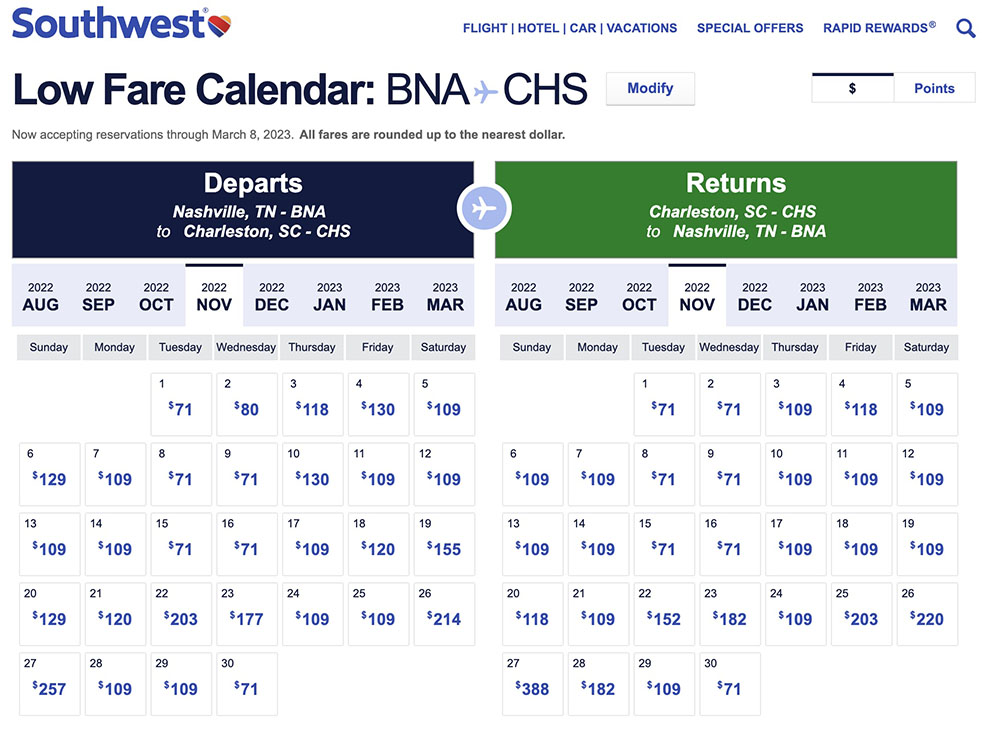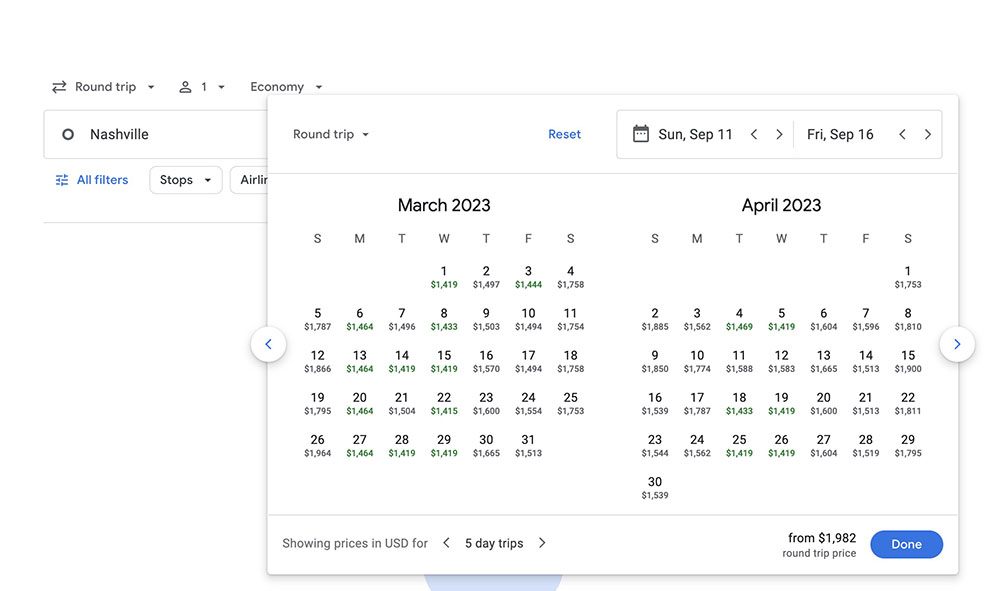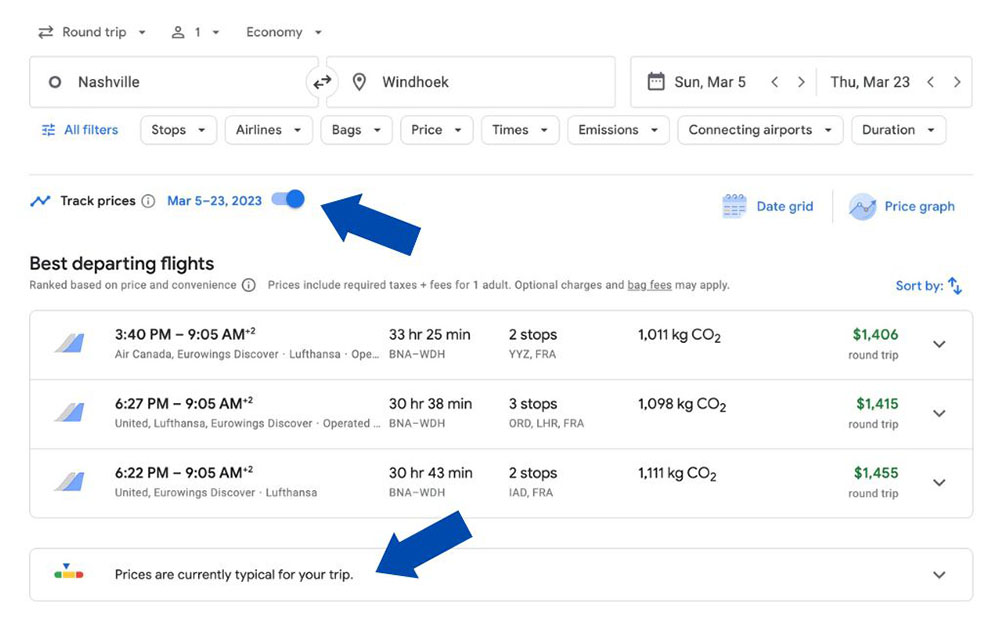For me, the most exciting part of any vacation often is the trip planning aspect. The second my husband or I dream up a potential destination, I’m compiling Airbnb recommendations, flight alerts flagged and a rough itinerary outlined within hours. If trip planning is something that overwhelms you, however, pull up a chair and I’ll give you a peek behind the curtain as to my process—here are the travel tools and websites I use as a jumping off point for any vacation.
This post was last updated in February 2025.
And if you’re just here for a greatest hits list of travel tools, here’s a round-up of sites and tools I swear by:
How I start trip planning
For me, every trip starts with finding the best flight deal, which helps me figure out when I want to travel. Generally, I have a good idea of the time of year, but my dates are fairly flexible, which is why I love that many airlines now have flexible search calendars.
Note: When using credit card points for flight redemptions, particularly overseas, it’s imperative you have flexibility within a certain date range. We’ve started targeting a month we want to travel about a year out, then planning our actual dates around the best rewards flights availability (lowest cost and best route). This is how we’ve traveled for extremely cheap to Thailand, Qatar, Australia and Hawaii the past three winters!
Related post: How We Went to Hawaii on Credit Card Points
Tracking flights
I typically prefer traveling in the off-season or shoulder season because that means less crowds and cheaper prices, but sometimes—like our summer trip to Europe with our niece—timing just isn’t that flexible, which is why flight alerts and tracking are my jam. I start tracking flights anywhere up to a year before a trip I’m considering.
Any frequent traveler will tell you that Google Flights is king, and I’m not going to steer you any differently. This is always where I begin my flight search: first by entering the route I want, entering approximately how long I’d like to travel, then using the flexible calendar feature to decide on the cheapest days for my trip.
Then, I set up a flight alert so I get an email if that flight route goes up or down in price before I book it. Google Flights will also tell you if the price is high for that time or typical, which I find helpful as it gives me a good guideline to know if I should wait for the price to go down or book when I find it’s normal or cheaper than average.
Important to note: Once you find the best flight for your trip, go to the airline’s website and book directly. Google Flights sometimes will show rates for OTAs (online travel agencies) like Expedia, and it’s never smart to book a flight via a third party, at least if you’re flying overseas and doling out thousands of dollars. (If it’s a $100 flight for a one-hour route from you, then by all means, tempt fate!
I’m of the mindset that you should book flights as far out as possible, especially if flying at peak times like holidays, but often the rule of thumb is to book six months before an international flight and one to four months before a domestic. That said, there’s no hard-and-fast “when is the best time to book flights?” answer anymore, so if you find a good deal that matches your budget, jump on that.
I’ve also been subscribed to the Going newsletter (formerly Scott’s Cheap Flights) since the very beginning of this flight alert email, and I love this free version for finding great air deals. It’s why we wound up going to Holland a few years back and why we were in Iceland on another cheap flight the following winter when $400 airfare landed in my inbox. I’ve never booked a flight so quickly!
Related Article: 13 Tips to Help You Survive Travel This Summer
Finding lodging
Before I pull the trigger on my flights, I then cross-reference my dates with lodging availability; usually finding something isn’t an issue unless you’re going to, say, Africa (which we’re doing in the spring!) where lodges are scarce and you truly need to book your accommodation 10 to 12 months out.
How cute was our chalet in Switzerland?
I’m an Airbnb girl despite my recent frustrations with them, but not everywhere in the world has a large selection of Airbnbs available; I find this particularly true for coastal and rural regions of the South. Booking.com has become my other go-to resource for lodging, especially overseas, as it consolidates hotels and vacation rentals. I’ve used it several times on U.S. vacations in the past couples years, too, as I’ve found the same listings on there as on Airbnb, only Booking charges a much lower service fee.
Booking rental cars
When traveling domestically, I’m typically loyal to Enterprise as I have a business account with them that gives me certain perks and cash back, but overseas where rental cars vary dramatically is another story. On recent trips, I’ve been using DiscoverCars.com to find the best deals on rental cars. Most recently, we rented a car in Switzerland for $966 for one week, whereas it was $1800 or more directly through the rental car companies. I pre-pay with this option and always put it on one of my travel cards that also includes insurance coverage so I can decline that at the car rental window.
Figuring out things to do
I use Google Images, friends’ travel blogs and social media to figure out what I want to do in whatever destinations I’m visiting. I typically have a list of several free or low-cost options that make the final itinerary, then budget for one big-ticket item like the helicopter ride in Iceland or a train ride to the top of Jungfrau in Switzerland.
My go-to booking sources for tours has been Get Your Guide for years (especially ever since Viator did me dirty). I find that, in many cases, the price is lower than if I were to book the attraction outright, and I’m always all about saving a dollar or 10.
Buying insurance
The only time I take out a separate insurance policy is when I’m doing a big trip like our safari next spring, for which I took out a trip insurance plan for SVV and me through World Nomads. Otherwise, I book all my trips on my AmEx Platinum and Chase cards (more on that later), each of which carries specific insurance and coverage for trip delays, trip interruptions, delayed baggage and more.
Other resources to help my trip plan
How I use credit card points to travel is an entire series of posts of its own. I’m a big proponent of the Chase Sapphire cards and the American Express suite of cards (I have the Plat, Biz Plat, Gold, Biz Gold and Blue) for anyone who wants to accrue points quickly and use them for flights and hotels. Not only do I get the points for purchases I’d already make, but all of my cards have so many add-on benefits that they quickly even out with the cost of the annual fee.
In the past year I’ve been getting serious about making my miles go even further; it turns out the more I study, the less I know, so I frequently refer to a host of points blogs and Facebook groups that have helped me learn the churn and burn of travel credit cards. Some of my favorites are 10x Travel, One Mile at a Time and The Points Guy. I also use Credit Karma and Mint, both free, to monitor my expenses and various credit cards, as well as the Rakuten plugin for cash back on pretty much every purchase I make online.
It’s definitely a lot of work, making charts and budget spreadsheets and referencing various sources before booking a trip, but I like to think it saves me a lot of money in the long run, so it’s completely worth the hours spent learning these various platforms! If you have any specific questions about my trip planning process, drop them in the comments.










دیدگاهتان را بنویسید